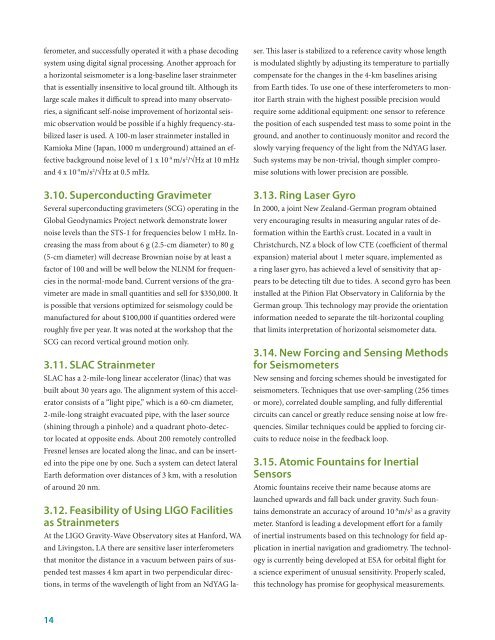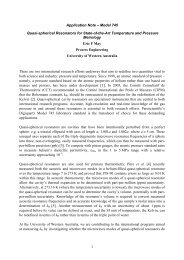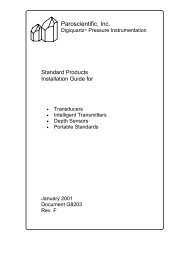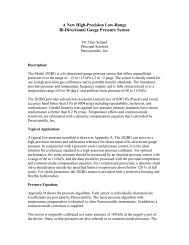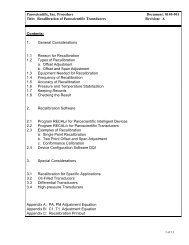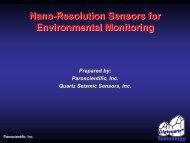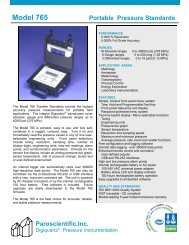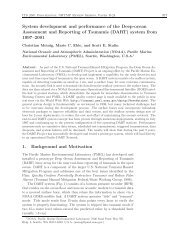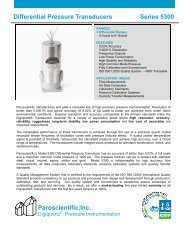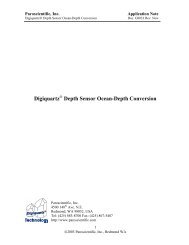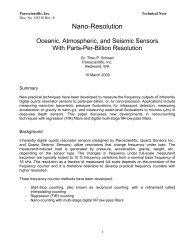FOR LOWïºFREQUENCY SEISMOMETRY - IRIS
FOR LOWïºFREQUENCY SEISMOMETRY - IRIS
FOR LOWïºFREQUENCY SEISMOMETRY - IRIS
- No tags were found...
Create successful ePaper yourself
Turn your PDF publications into a flip-book with our unique Google optimized e-Paper software.
ferometer, and successfully operated it with a phase decodingsystem using digital signal processing. Another approach fora horizontal seismometer is a long-baseline laser strainmeterthat is essentially insensitive to local ground tilt. Although itslarge scale makes it difficult to spread into many observatories,a significant self-noise improvement of horizontal seismicobservation would be possible if a highly frequency-stabilizedlaser is used. A 100-m laser strainmeter installed inKamioka Mine (Japan, 1000 m underground) attained an effectivebackground noise level of 1 x 10 -9 m/s 2 /√Hz at 10 mHzand 4 x 10 -9 m/s 2 /√Hz at 0.5 mHz.3.10. Superconducting GravimeterSeveral superconducting gravimeters (SCG) operating in theGlobal Geodynamics Project network demonstrate lowernoise levels than the STS-1 for frequencies below 1 mHz. Increasingthe mass from about 6 g (2.5-cm diameter) to 80 g(5-cm diameter) will decrease Brownian noise by at least afactor of 100 and will be well below the NLNM for frequenciesin the normal-mode band. Current versions of the gravimeterare made in small quantities and sell for $350,000. Itis possible that versions optimized for seismology could bemanufactured for about $100,000 if quantities ordered wereroughly five per year. It was noted at the workshop that theSCG can record vertical ground motion only.3.11. SLAC StrainmeterSLAC has a 2-mile-long linear accelerator (linac) that wasbuilt about 30 years ago. The alignment system of this acceleratorconsists of a “light pipe,” which is a 60-cm diameter,2-mile-long straight evacuated pipe, with the laser source(shining through a pinhole) and a quadrant photo-detectorlocated at opposite ends. About 200 remotely controlledFresnel lenses are located along the linac, and can be insertedinto the pipe one by one. Such a system can detect lateralEarth deformation over distances of 3 km, with a resolutionof around 20 nm.3.12. Feasibility of Using LIGO Facilitiesas StrainmetersAt the LIGO Gravity-Wave Observatory sites at Hanford, WAand Livingston, LA there are sensitive laser interferometersthat monitor the distance in a vacuum between pairs of suspendedtest masses 4 km apart in two perpendicular directions,in terms of the wavelength of light from an NdYAG laser.This laser is stabilized to a reference cavity whose lengthis modulated slightly by adjusting its temperature to partiallycompensate for the changes in the 4-km baselines arisingfrom Earth tides. To use one of these interferometers to monitorEarth strain with the highest possible precision wouldrequire some additional equipment: one sensor to referencethe position of each suspended test mass to some point in theground, and another to continuously monitor and record theslowly varying frequency of the light from the NdYAG laser.Such systems may be non-trivial, though simpler compromisesolutions with lower precision are possible.3.13. Ring Laser GyroIn 2000, a joint New Zealand-German program obtainedvery encouraging results in measuring angular rates of deformationwithin the Earth’s crust. Located in a vault inChristchurch, NZ a block of low CTE (coefficient of thermalexpansion) material about 1 meter square, implemented asa ring laser gyro, has achieved a level of sensitivity that appearsto be detecting tilt due to tides. A second gyro has beeninstalled at the Piñion Flat Observatory in California by theGerman group. This technology may provide the orientationinformation needed to separate the tilt-horizontal couplingthat limits interpretation of horizontal seismometer data.3.14. New Forcing and Sensing Methodsfor SeismometersNew sensing and forcing schemes should be investigated forseismometers. Techniques that use over-sampling (256 timesor more), correlated double sampling, and fully differentialcircuits can cancel or greatly reduce sensing noise at low frequencies.Similar techniques could be applied to forcing circuitsto reduce noise in the feedback loop.3.15. Atomic Fountains for InertialSensorsAtomic fountains receive their name because atoms arelaunched upwards and fall back under gravity. Such fountainsdemonstrate an accuracy of around 10 -9 m/s 2 as a gravitymeter. Stanford is leading a development effort for a familyof inertial instruments based on this technology for field applicationin inertial navigation and gradiometry. The technologyis currently being developed at ESA for orbital flight fora science experiment of unusual sensitivity. Properly scaled,this technology has promise for geophysical measurements.14


